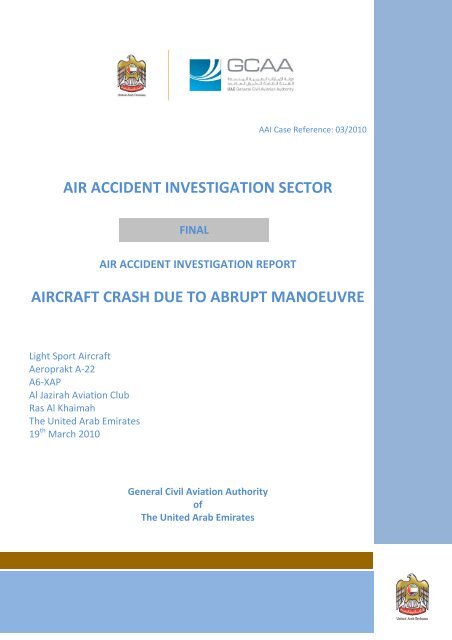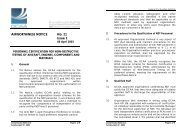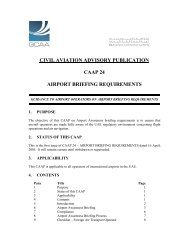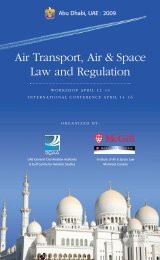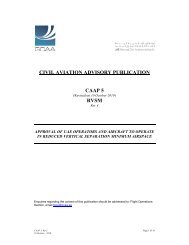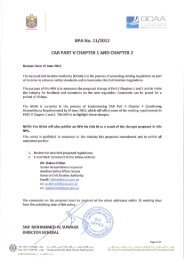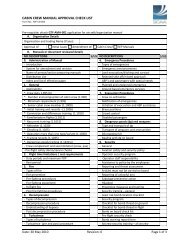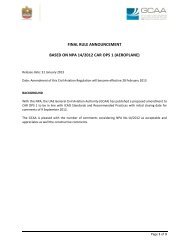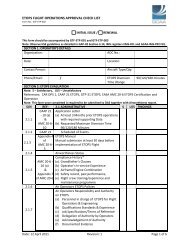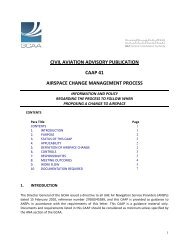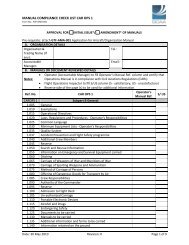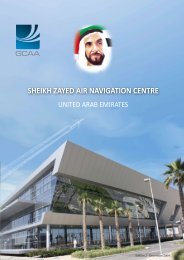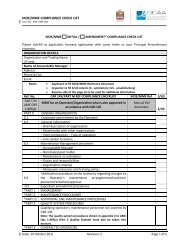Investigation Final Report of Aeroprakt A-22 Light Sport Aircraft ...
Investigation Final Report of Aeroprakt A-22 Light Sport Aircraft ...
Investigation Final Report of Aeroprakt A-22 Light Sport Aircraft ...
Create successful ePaper yourself
Turn your PDF publications into a flip-book with our unique Google optimized e-Paper software.
AAI Case Reference: 03/2010AIR ACCIDENT INVESTIGATION SECTOR- Accident- Serious Incident- IncidentFINAL- Accident- Serious Incident- IncidentAIR ACCIDENT INVESTIGATION REPORTAIRCRAFT CRASH DUE TO ABRUPT MANOEUVRE<strong>Light</strong> <strong>Sport</strong> <strong>Aircraft</strong><strong>Aeroprakt</strong> A-<strong>22</strong>A6-XAPAl Jazirah Aviation ClubRas Al KhaimahThe United Arab Emirates19 th March 2010AAI Form 036 (November 2011)General Civil Aviation Authority<strong>of</strong>The United Arab EmiratesAIR ACCIDENT DRAFT FINAL REPORT 10/2009, DATED APRIL 15 th , 2012i
Air Accident <strong>Investigation</strong> SectorGeneral Civil Aviation AuthorityThe United Arab EmiratesOBJECTIVEThis investigation is performed in accordance with the UAEFederal Act No 20 <strong>of</strong> 1991, promulgating the Civil Aviation Law,Chapter VII, <strong>Aircraft</strong> Accidents, Article 48, and in conformity toICAO Annex 13 to the Chicago Convention.The sole objective <strong>of</strong> this investigation is to prevent aircraftaccidents and incidents. It is not the purpose <strong>of</strong> this activity toapportion blame or liability.AIR ACCIDENT FINAL REPORT 03/2010, DATED SEPTEMBER 6 th , 2012ii
AIRCRAFT ACCIDENT BRIEFGCAA AAI <strong>Report</strong> No.: 03/2010Operator:Al Jazirah Aviation Club<strong>Aircraft</strong> Type and Registration: <strong>Aeroprakt</strong> A-<strong>22</strong>, A6-XAPNo. and Type <strong>of</strong> Engines: OneDate and Time (UTC):19 th March, 2010, 1300 LTLocation: 150 meters southwest <strong>of</strong> runway 28Type <strong>of</strong> Flight:GeneralPersons on Board: 2Injuries:2, Serious InjuriesNature <strong>of</strong> Damage:<strong>Aircraft</strong> destroyedThe Accident, <strong>Aeroprakt</strong> A-<strong>22</strong> <strong>Aircraft</strong>, registration number A6-XAP, was notified to the General CivilAviation Authority (“GCAA”), on March 19 th 2010 at about 1300 LT.A team was formed and launched immediately and reached the accident site within minutes after thenotification received from Al Jazirah Aviation Club. The team coordinated with all Authorities on site byinitiating the accident investigation process according to the already prepared and exercised plans. TheAir Accident <strong>Investigation</strong> Sector (“AAIS”) <strong>of</strong> the GCAA lead the <strong>Investigation</strong> as the United ArabEmirates (“UAE”) is the State <strong>of</strong> Occurrence.Notes:1 The word (“<strong>Aircraft</strong>”) in this <strong>Report</strong> implies the accident aircraft.2 The word (“Team”) in this report implies the Accident <strong>Investigation</strong> Team leadby an Investigator-In-Charge assigned by the GCAA <strong>of</strong> the UAE andencompassed investigators from the GCAA.3 All times in this <strong>Report</strong> are LT Coordinated Universal Time (“UTC”) (UTC= UAELocal Time -4 hours).AIR ACCIDENT FINAL REPORT 03/2010, DATED SEPTEMBER 6 th , 2012iii
TABLE OF CONTENTSOBJECTIVEAIRCRAFT ACCIDENT BRIEFiiiiiTABLE OF CONTENTS 1LIST OF ABBREVIATIONS 31. FACTUAL INFORMATION 41.1 HISTORY OF FLIGHT 41.2 INJURIES TO PERSONS 41.3 DAMAGE TO AIRCRAFT 51.4 OTHER DAMAGE 51.5 PERSONNEL INFORMATION 51.6 AIRCRAFT INFORMATION 51.6.1 Airframe Information 51.6.2 Flight Limitations 51.6.3 Engine Information 61.6.4 Fuel grade 61.6.5 Weights’ Limitations 71.6.6 <strong>Aircraft</strong> Maintenance History 71.7 METEOROLOGICAL INFORMATION 71.8 AIDS TO NAVIGATION 71.9 COMMUNICATIONS 71.10 AERODROME FORMATION 71.11 FLIGHT RECORDERS 81.12 WRECKAGE AND IMPACT INFORMATION 81.13 MEDICAL AND PATHOLOGICAL INFORMATION 91.14 FIRE 91.15 SURVIVAL ASPECTS 91.16 TESTS AND RESEARCH 91.17 ORGANISATIONAL AND MANAGEMENT INFORMATION 91.18 ADDITIONAL INFORMATION 91.19 USEFUL OR EFFECTIVE INVESTIGATION TECHNIQUES 102. ANALYSIS 113. CONCLUSIONS 133.1 GENERAL 133.2 FINDINGS 13AIR ACCIDENT FINAL REPORT 03/2010, DATED SEPTEMBER 6 th , 2012 1
3.3 CAUSES 133.4 CONTRIBUTING FACTORS TO THE ACCIDENT 133.5 OTHER FINDINGS 144. SAFETY RECOMMENDATIONS 154.1 GENERAL 154.2 RECOMMENDATIONS TO AL JAZIRAH CLUB 154.2 RECOMMENDATIONS TO THE GCAA 15APPENDIX A- ENGINE POWER SETTING CHART 16APPENDIX B- CIRCUIT PATTERNS AS CONTAINED IN THE CLUB’S MANUAL 17APPENDIX C- CIRCUITS PATTERNS OF BOTH RUNWAYS 19AIR ACCIDENT FINAL REPORT 03/2010, DATED SEPTEMBER 6 th , 2012 2
LIST OF ABBREVIATIONSAGLAbove Ground LevelAIPAeronautical Information Publication°C Degrees Celsius (Temperature measurement unit)C.GCenter <strong>of</strong> gravityCHT Cylinder head temperature, °CEEastEGT/MAG Exhaust gas temp, magneto side, °CEGT/PTO Exhaust gas temp, propeller side, °CftFeet (British distance measurement unit)hpHorsepowerkgKilogram (International Standard mass measurement unit)ktsKnots (Airspeed measurement unit)LbPounds (British mass unit)LTLocal Time <strong>of</strong> the United Arab Emirates (+7 hours UTC)LSA<strong>Light</strong> <strong>Sport</strong> <strong>Aircraft</strong>MAGMagnetoMTOWMaximum Take<strong>of</strong>f WeightNNorthNMNautical MilesPsipounds per square inch (Pressure measurement unit)RPMRevolution Per MinuteRWYRunwayUTCUniversal Coordinated TimeVFRVisual Flight RulesAIR ACCIDENT FINAL REPORT 03/2010, DATED SEPTEMBER 6 th , 2012 3
1. FACTUAL INFORMATION1.1 HISTORY OF FLIGHTOn 19 th March 2010, an <strong>Aeroprakt</strong> <strong>22</strong> (‘A-<strong>22</strong>’), registration mark A6-XAP, took <strong>of</strong>f from runway (‘RWY’)28 at approximately 1215 LT with two persons onboard: one pilot and one passenger.The Accident flight was the second during that day; the first flight was conducted in the early morningwith the same pilot and different passenger.The <strong>Aircraft</strong> departed the ramp at around 1213 LT to reach runway 28 with no mechanical anomalies.After take<strong>of</strong>f, the engine power was continuously variated by the pilot to manage the in-flightmanoeuvrability. The recorded engine parameters showed that the engine power was advanced tomaximum take<strong>of</strong>f power and kept for 45 seconds; thereafter the power was reduced to 4000 RPM tostay for around 7 minutes and 20 seconds.The engine power then increased to 4400 RPM and continued for around 2 minutes before reduced to3820 RPM and stay constant for 1 minute and 50 seconds. During the next 2 minutes, the power wasfluctuating between 2350 and 3110 RPM before being increased gradually to 4000 RPM.The pilot stated that on the final approach to runway 28, the windsock observation suggestedfavourability <strong>of</strong> runway 34 and a go-around decision was made at around 300 ft before touchdown tojoin traffic pattern for landing at runway 34.The <strong>Aircraft</strong> banked 30° to the left turn down wind, and while at approximately 150-200 ft AboveGround Level (‘AGL’), the <strong>Aircraft</strong> started to lose altitude until it became ahead <strong>of</strong> 14 ft elevated sanddune, the pilot advanced the engine power abruptly to ‘Maximum’ and commanded nose-up elevator.The <strong>Aircraft</strong> went into a stall and immediately sank towards the ground until its nose landing gearimpacted the dune.The nose landing gear broke and the <strong>Aircraft</strong> continued airborne for about 66 ft until it completelystopped with nose heading (37° North ), at approximately 500 ft southwest <strong>of</strong> RWY 28.The pilot and the passenger were rescued by the local police emergency after they sustained seriousinjuries.The <strong>Aircraft</strong> destroyed with no subsequent fire.1.2 INJURIES TO PERSONSInjuries Flight Crew Cabin Crew Passengers Other TotalFatal - - - - -Serious 1 - 1 - 2Minor - - - - -None - - - - -AIR ACCIDENT FINAL REPORT 03/2010, DATED SEPTEMBER 6 th , 2012 4
Total 1 - 1 - 21.3 DAMAGE TO AIRCRAFTThe <strong>Aircraft</strong> was destroyed due to the significant impact.1.4 OTHER DAMAGENone.1.5 PERSONNEL INFORMATIONThe pilot was a member <strong>of</strong> the Club and possessed a flying permit to practice his flying activity; hereceived on-type training in the Club before he started to fly.The pilot used to fly during weekends, his total on-type flying time was 52 hours.The pilot was not suffering from any fatigue or sickness during the day <strong>of</strong> the Accident.1.6 AIRCRAFT INFORMATION1.6.1 Airframe InformationThe A-<strong>22</strong>, MSN 268, was a non-aerobatic, <strong>Light</strong> <strong>Sport</strong> <strong>Aircraft</strong> (‘LSA’), manufactured by <strong>Aeroprakt</strong> Ltd,Ukraine.The A-<strong>22</strong> was designed for recreational flying and primary training in daytime VFR flight from grass orhard runways. It was a metal air-framed high-wing strut braced monoplane with side-by-side seatingand extensive cockpit glazing. The fixed tricycle landing gear had hydraulic brakes and a steerable nosewheel linked to the rudder pedals.The standard power unit was a 100 hp, Rotax 912ULS, driving a ground adjustable 3-blade compositepropeller. Two wing tanks gave a total fuel capacity <strong>of</strong> 92 liters.1.6.2 Flight LimitationsThe following were the limitations mentioned in the A-<strong>22</strong> Operator & Maintenance Manual (‘A-<strong>22</strong>Manual’) 1 :- Aerobatics, banked turns over 60°, intentional spinning and accelerated stalls areprohibited.- V ne – (Never exceed speed) 108 kts- V no – (Maximum structural speed) 80 kts- V a – (Maneuvering speed) 70 ktsDo not make full or abrupt control movements above this speed.1A-<strong>22</strong> Manual is similar to the Pilot’s Operating HandbookAIR ACCIDENT FINAL REPORT 03/2010, DATED SEPTEMBER 6 th , 2012 5
- V y – (Best rate <strong>of</strong> climb, no flap) 57 kts- V f – (Flaps extended speed) 59 ktsDo not exceed V f with the flaps extended- Best L/D - (best glide speed, flaps up) 52 kts- V s1 – (Stall, no flaps and wing level) 32 kts- V so – (Stall, with full flaps and wing level) 27 ktsA hint was contained in the A-<strong>22</strong> Manual stating: ‘Add 4-10 kts to these speeds for stalls in turns’.1.6.3 Engine InformationThe Rotax 912 ULS was a 4-Cylinder with 4-stroke liquid/air-cooled engine with opposed cylinders, twocarburettors and dual-electronic ignition.The engine starts electrically, equipped with propeller speed reduction unit and air intake system.The engine was a non-certified ‘Aviation Product’ engine, the time between overhauls was 2,000 hrs.The following were the specifications <strong>of</strong> the engine:- Maximum engine speed: 5800 RPM (maximum 5 minutes)- Maximum continuous speed: 5500 RPM- Dual ignition check: 4000 RPM- Normal idle: 1800-2100 RPM- Minimum idle: 1400-1800 RPM- Maximum exhaust gas temperature: 880 °C (normal: 760–800 °C).- Maximum cylinder head temperature: 130 °C (normal 95–100 °C).- Minimum oil temperature for take<strong>of</strong>f: 50 °C (normal 85–110 °C)- Maximum oil temperature: 130°.- Minimum oil pressure: 0.8 bar/12 psi- Maximum oil pressure: 7.0 bar/95 psi- Normal oil pressure: 2-5 bar/30-75 psiAppendix A shows the recorded engine RPM versus time.1.6.4 Fuel gradePremium Unleaded octane rating 95 (or better) - normal useAvgas - acceptable providing mineral engine oil is used and changed more frequently.AIR ACCIDENT FINAL REPORT 03/2010, DATED SEPTEMBER 6 th , 2012 6
1.6.5 Weights’ LimitationsThe empty weight was 263 kg (580 lb) +/-2%, MTOW 525 kg (1157.5 lb) [450 kg (992 lb) Australia,472.5 kg (1041.7 lb) with parachute], maximum cockpit load 172 kg (379.2 lb), minimum cockpit load55 kg (121.25 lb), and maximum luggage bin 25 kg (55.1).The C <strong>of</strong> G datum and range:Datum– Front face <strong>of</strong> propeller mounting-flangeAOD– 4.72 to 5.71 ft aft <strong>of</strong> datum, aircraft level with reference to the lower door valances.1.6.6 <strong>Aircraft</strong> Maintenance HistoryReviewing the <strong>Aircraft</strong> maintenance records did not reveal any mechanical defects.1.7 METEOROLOGICAL INFORMATIONThere was no significant meteorological condition in the area at the time <strong>of</strong> the Accident.1.8 AIDS TO NAVIGATIONThe Accident flight was VFR.1.9 COMMUNICATIONSNot a factor.1.10 AERODROME FORMATIONAl Jazirah Aviation Club Airport is a GCAA certificated airport that was built at a desert area located inRas Al Khaimah, the United Arab Emirates, to serve the club’s operations.The UAE Aeronautical Information Publication (‘AIP’) contains the Airport’s specifications as shown inthe below table.Al Jazirah ‘OMRJ’RunwaysElevationTypes <strong>of</strong> traffic permitted (IFR/VFR)Aerodrome obstaclesTwo crossing 10/28 and 16/34 crossing eachother at 253955N 0554627E.RWY 16/34: 1640 x 65.6 ft, tarmacRWY 10/28: 984 x 65.6 ft, compacted sand10 ftVFR only- MAST- 1050 ftAIR ACCIDENT FINAL REPORT 03/2010, DATED SEPTEMBER 6 th , 2012 7
- Day/VFR- 253923.92 N 0554520.68 E- 243° 1.14 NM from ARPCircuit patterns- Left hand circuit, 500 ft at RWY 16- Right hand circuit at 500 ft at RWY 341.11 FLIGHT RECORDERSThe engine was equipped with FLYdat display system that monitors the following parameters:- RPM - engine speed, revolutions per minute- HOURS - hours <strong>of</strong> operation, x 0.1 hour- EGT/PTO - exhaust gas temp, propeller side, °C- EGT/MAG - exhaust gas temp, magneto side, °C- CHT - cylinder head temperature, °C- EGT display - cylinders for EGT- OIL TEMP - oil temperature, °C- OIL PRESS - oil pressure x 0.1 barThe FLYdat was collected by the <strong>Investigation</strong> and shipped to the engine manufacturer where it wasdownloaded and the engineering data processed.1.12 WRECKAGE AND IMPACT INFORMATIONThe location <strong>of</strong> the impact was at approximately 500ft meters southwest <strong>of</strong> RWY 28. The <strong>Aircraft</strong> was inone unit except the nose landing gear which detachedand found (65 ft) before the <strong>Aircraft</strong> final stop.The nose <strong>of</strong> the <strong>Aircraft</strong> was heading to approximately(37°). The airspeed indicator was pointing toapproximately 35 km/hr (18.9 kts), the vertical speedand altitude indicators were pointing to zero,Figure 1 illustrates the distribution <strong>of</strong> the mainwreckage pieces at the Accident site.Figure 1- Wreckage distribution diagramAIR ACCIDENT FINAL REPORT 03/2010, DATED SEPTEMBER 6 th , 2012 8
1.13 MEDICAL AND PATHOLOGICAL INFORMATIONNo psychoactive material was found in the blood <strong>of</strong> the pilot.1.14 FIREThere was no pre- or post-impact fire.1.15 SURVIVAL ASPECTSThe pilot and passenger were evacuated by the local police ambulance to a nearby hospital.1.16 TESTS AND RESEARCHNone.1.17 ORGANISATIONAL AND MANAGEMENT INFORMATIONAl Jazirah Aviation Club was certificated by the GCAA under Part IV, Section D- Ultralight andMicrolight Operations, <strong>of</strong> the Civil Aviation Regulations.The Club was being managed by a GCAA’s accepted organisation structure depicted in the Club’sOperations Manual.The Club was authorised to operate micrloight and ultralight aircraft within certificated vicinity, andfacilitated with maintenance hangar and training classes.The operation was approved under VFR/Daytime only; operational control and authority to releaseflights were under the Club’s ‘Chief Flying Instructor’.According to the Club’s Manual, each flight plan shall include information <strong>of</strong> date and time, route,aircraft type and registration, colour and identifying marks, radio, if installed, and pilot in command.1.18 ADDITIONAL INFORMATIONThe pilot stated that when he joined the Club, someone from the Club had briefed him on the Club’sprocedure while the Club manual was not provided to him, he was only provided with a copy <strong>of</strong> the A-<strong>22</strong> Operator & Maintenance Manual. The pilot added that he used to see the ‘circuit pattern RWY 28’chart at the wall, when the pilot was asked <strong>of</strong> why he didn’t follow that applicable pattern whenlanding on RWY 34, he answered that he was not doing ‘overshoot’ on RWY 28 when he decided tochange the landing to RWY 34.According to the Club’s Operations Manual, circuit pattern flight for RWY 34 should be initiated to theright while it should be to the left for RWY 16. Traffic pattern altitude should be 800 ft AGL. <strong>Aircraft</strong>joining the circuit should join on the downwind side <strong>of</strong> the circuit only after passing overhead centrefield at not less than 1000 ft and not more than 1400 ft AGL. Vertical limitations were to be strictlyfollowed, which was not more than 1400 ft AGL and not less than 500 ft AGL. (Appendix B).AIR ACCIDENT FINAL REPORT 03/2010, DATED SEPTEMBER 6 th , 2012 9
According to the A-<strong>22</strong> Manual, the missed approach and go-around could be performed in twomethods:- Method One. From “clean” flaps up approach, increase power smoothly to full power whilstgradually raising the nose. The aircraft will accelerate quite rapidly in this situation so be carefulwith ground and obstacle clearance. Establish a 60 kts climb attitude and trim for stick “neutral”.- Method Two. From a short-field full flap approach, increase power smoothly and sufficiently toestablish a climb whilst keeping the stick in the same pitch position. Do not exceed V f (the flaplimiting speed <strong>of</strong> 59 kts).The A-<strong>22</strong> Manual also dictated to apply a forward pressure to maintain the same pitch position whenincreasing power for a go-round and to adjust the trim accordingly. Raising flaps before climbing to200 ft with positive climb was prohibited by the A-<strong>22</strong> Manual. When positive climb is ensured, ‘halfflap’ position could be selected with increase to full power. The A-<strong>22</strong> Manual allowed for flying a smallcircuit in this configuration.A ‘Warning’ in the A-<strong>22</strong> Manual prohibited pilots to raise the flaps suddenly at low level, either on theapproach or climb-out, because the aircraft will sink noticeably as the flaps retract. The position <strong>of</strong> thecockpits flaps’ handle showed that the flaps were set at position 1 (out <strong>of</strong> three positions- 0, 1 and 2,see figure 2), that position was not covered in any <strong>of</strong> the ‘missed approach and go-around’ twomethods mentioned above.Figure 2- Flaps’ handle1.19 USEFUL OR EFFECTIVE INVESTIGATION TECHNIQUESNone.AIR ACCIDENT FINAL REPORT 03/2010, DATED SEPTEMBER 6 th , 2012 10
2. ANALYSISThe wreckage investigation revealed no <strong>Aircraft</strong> performance anomalies or mechanical malfunctions:the flight controls were moved freely, no pre-impact damage marks were observed. When moving thecockpit handles and pedals by the investigators, the flight control cables, rods and motions convertersexhibited normal power transfer to the ailerons, elevator and rudder.The free movement <strong>of</strong> the control surfaces and the <strong>Aircraft</strong> integrity prior to the impact excluded theprobability <strong>of</strong> controllability loss due to failure <strong>of</strong> any primary or secondary flight control surface, orany <strong>of</strong> power transfer means.The field examination <strong>of</strong> the engine revealed that the engine was functioning normally: the induction,fuel, ignition, cooling and lubrication systems were intact with no indication <strong>of</strong> in-flight deficiency orsigns <strong>of</strong> malfunction. The engine reader’s downloaded data confirmed that there was a consistentresponse <strong>of</strong> the engine within the different phases <strong>of</strong> the flight.The flight was normal until the time when the pilot decided to change the landing runway from RWY28 to RWY 34 and the associated go-around decision. When the pilot made that decision, heimmediately commanded the <strong>Aircraft</strong> for a left turn to catch RWY 34 while he was at low altitude.According to the Club’s Operations Manual, and according to the published AIP, approaching RWY 34should be from the right side, i.e after the go-around from RWY 28, the <strong>Aircraft</strong> should continueclimbing, follow the RWY 34 circuit pattern before the final approach to RWY 34 (blue line in AppendixC).The location <strong>of</strong> the crash site, its distance from RWY 34, the airspeed indicator’s reading, and the shortperiod <strong>of</strong> power increase, would introduce to the <strong>Investigation</strong> a clue that the turn was startedimmediately after the go-around was initiated.In general, an increase in bank angle requires increasing the lift to maintain the aircraft in level flightduring its climb, the increase in lift depends on the bank angle: the more bank angle the more lift isrequired to compensate for the lost lift component due to bank.When the <strong>Aircraft</strong> bank angle was increased during the left turn to RWY 34, and in order to maintainaltitude while turning in steady coordinated, constant altitude and constant speed turn, the requiredlift should have been the result <strong>of</strong> the weight divided by the cosine <strong>of</strong> the bank angle. 2In order to increase the lift to the required amount <strong>of</strong> maintaining steady coordinated turn, the pilotshould have commanded nose-up elevator input to compensate for the nose down pitch moment.The more lift required to compensate for the bank angle results in an increase in the induced dragwhich should be overcome by more thrust.2In a steady state turn:Ʃ Vertical forces= W- L cos ᵩ = 0 → L= W/ cos ᵩ → L/W= 1/cos ᵩ= G, Where L= the required lift for steadystate turn, W=weight, ᵩ= Bank angle, G= load factor.........................................................................Equation (1)Ʃ Horizontal forces= L sin ᵩ = m x a r = m x (V 2 /r) = (W/g) x (V 2 /r), where m= aircraft mass, a r = radialacceleration <strong>of</strong> the aircraft, V= speed, r= horizontal turn radius, g= acceleration due to gravity…..Equation (2)Dividing equation (2) by equation (1):(L sin ᵩ/ L cos ᵩ)= (W/g)(V 2 /r)(1/W)i.e.tan ᵩ= V 2 /gr; r= V 2 /g tan ᵩ; or ᵩ= tan -1 (V 2 /gr)AIR ACCIDENT FINAL REPORT 03/2010, DATED SEPTEMBER 6 th , 2012 11
The left turn performed by the pilot was initiated at low level which did not avail an opportunity tomaintain the altitude and/or take any recovery reaction. The <strong>Aircraft</strong> continued in losing altitude,while the pilot had no proper input by elevator and throttle commands, until the sudden appearance<strong>of</strong> the dune to the pilot.At that moment, the pilot tried to avoid the impact by sudden nose-up elevator and maximumthrottle, the <strong>Aircraft</strong> did not efficiently respond and went into a stall where aerodynamic control wasnot sufficient to recover.The Club’s Manual did not contain adequate procedure to change the originally planned landingrunway. In addition to that, the Manual did not contain procedure for maintaining records pertinent tothe take<strong>of</strong>f load sheets and weights <strong>of</strong> the persons boarding the flight, that deprived the <strong>Investigation</strong>from determining whether the take<strong>of</strong>f mass or C.G position were contributing to the Accident or not.AIR ACCIDENT FINAL REPORT 03/2010, DATED SEPTEMBER 6 th , 2012 12
3. CONCLUSIONS3.1 GENERALFrom the evidence available, the following findings, causes and contributing factors were made withrespect to this Accident, these findings and contributing factors shall not be read as apportioningblame or liability to any particular organisation or individual.The following sections were included in the ‘Conclusions’ heading to serve the objective <strong>of</strong> this<strong>Investigation</strong>.3.2 FINDINGS(a)The pilot possessed a properly issued ‘flying permit’.(b)(c)(d)(e)(f)The <strong>Aircraft</strong> was properly registered and issued a ‘flight permit’.The <strong>Aircraft</strong> did not suffer from any mechanical defects that might have contributed to theAccident.The <strong>Aircraft</strong> engine was functioning normally.There was no evidence <strong>of</strong> psychoactive influence that might have adversely affected the pilotperformance during the flight.There was no significant whether in the vicinity <strong>of</strong> the flying area at the time <strong>of</strong> the Accident.3.3 CAUSESThe Air Accident <strong>Investigation</strong> Sector determines that the causes <strong>of</strong> the Accident were:The pilot decision to perform a go-around from RWY 28 and to change the landing to RWY 34 by,improperly, making a left turn associated with bank, at low altitude without taking the necessaryactions to maintain coordinated turn, resulting in losing altitude followed by improper impactavoidance reaction causing the <strong>Aircraft</strong> to enter into a stall, to sink and impact the ground.3.4 CONTRIBUTING FACTORS TO THE ACCIDENT(a)(b)(c)The pilot did not follow the standard practice procedures for establishing safe approach andlanding when he decided to change the landing runway by following improper joining patternto the new landing runway.The pilot’s situational awareness did not qualify him to realise that the <strong>Aircraft</strong> was losingaltitude while turning.The pilot did not take the proper training in the Club’s landing and take<strong>of</strong>f procedures on RWY34 or RWY 28.AIR ACCIDENT FINAL REPORT 03/2010, DATED SEPTEMBER 6 th , 2012 13
(d)The Club’s Operations a Manual did not contain adequate procedure pertinent to changing alanding runway in case <strong>of</strong> any unforeseen weather or other conditions.3.5 OTHER FINDINGS(a)The Club’s Operations Manual did not contain procedure pertinent to recording the weights <strong>of</strong>the pilot and passenger and insert that into a properly maintained load sheet.AIR ACCIDENT FINAL REPORT 03/2010, DATED SEPTEMBER 6 th , 2012 14
4. SAFETY RECOMMENDATIONS4.1 GENERALThe ‘Safety Recommendations’ listed in this <strong>Report</strong> are proposed according to paragraph 6.8<strong>of</strong> Annex 13 to the Chicago Convention, and are based on the ‘Findings’, ‘Contributing Factors’and ‘Other Findings’ listed in Section 3 <strong>of</strong> this <strong>Report</strong>, the GCAA expects that all safety issues,identified by the <strong>Investigation</strong> in Section 3, are addressed by the receiving organizations.4.2 RECOMMENDATIONS TO AL JAZIRAH CLUBSR 20/2012To revise the Operations Manual to include procedures for:(a) Changing the landing runway.(b) Weighing the pilots and passengers in the beginning <strong>of</strong> each flying day and maintainrecord for the generated load sheet.SR 21/2012To conduct <strong>of</strong>ficial training on the Operations Manual and the related <strong>Aircraft</strong> Manuals beforeflying any aircraft type.SR <strong>22</strong>/2012To establish a system for pilots’ performance monitoring and assessment.SR 23/2012To enhance information communication system, especially those related to ‘criticalinformation’, to pilots.SR 24/2012To enhance the quality management system in order to ensure that all the necessary safetyissues are considered and communicated within the Club’s organisation and amongst thepilots.4.2 RECOMMENDATIONS TO THE GCAASR 25/2012To improve the Civil Aviation Regulations related to <strong>Light</strong> <strong>Sport</strong> <strong>Aircraft</strong> and operations.Air Accident <strong>Investigation</strong> SectorGeneral Civil Aviation AuthorityThe United Arab EmiratesAIR ACCIDENT FINAL REPORT 03/2010, DATED SEPTEMBER 6 th , 2012 15
APPENDIX A- ENGINE POWER SETTING CHARTTake<strong>of</strong>f & climb00:27:27-00:28:30Total time – 00:01:05Cruise00:28:30-00:35:40Total time – 00:07:10Descent00:35:35-00:37:30Total time – 00:01:55Impact00:42:10TaxiLow pass00:39:45-00:41:30Total time – 00:01:30Engine runGo-around00:41:35-00:42:10Total time – 00:00:35Engine start00:25:52NOTES:- Hours counter in the above chart was re-set to ‘00’ for clarity.- The events depicted in the above chart were extracted from the engine power settings, no other evidence could support them.AIR ACCIDENT FINAL REPORT 03/2010, DATED SEPTEMBER 6 th , 2012 16
RWY 28APPENDIX B- CIRCUIT PATTERNS AS CONTAINED IN THE CLUB’S MANUALAIR ACCIDENT FINAL REPORT 03/2010, DATED SEPTEMBER 6 th , 2012 17
RWY 34AIR ACCIDENT FINAL REPORT 03/2010, DATED SEPTEMBER 6 th , 2012 18
APPENDIX C- CIRCUITS PATTERNS OF BOTH RUNWAYSAIR ACCIDENT FINAL REPORT 03/2010, DATED SEPTEMBER 6 th , 2012 19


